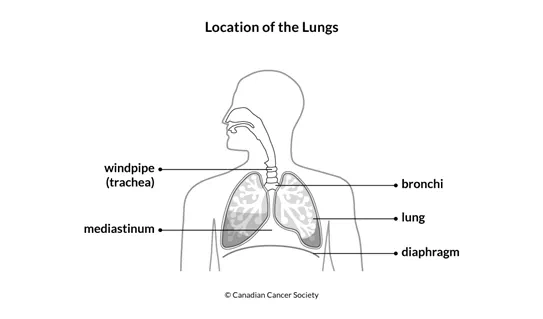What is lung cancer?
Lung cancer starts in the cells of the lung. A cancerous (malignant) tumour is a group of cancer cells that can grow into and destroy nearby tissue. It can also spread (metastasize) to other parts of the body. When cancer starts in lung cells, it is called primary lung cancer.
The lung is part of the respiratory system. You use your lungs when you breathe. The lungs are in the chest, one on each side of the heart. The right lung has 3 main parts, called lobes. The left lung is a bit smaller and has 2 lobes. The lungs are cushioned and protected by a thin covering called the pleura.

Cells in the lung sometimes change and no longer grow or behave normally. These changes may lead to non-cancerous (benign) tumours such as hamartoma and papilloma. But in some cases, changes to lung cells can cause cancer.
Lung cancers are divided into non–small cell lung cancer and small cell lung cancer based on the type of cell in which the cancer started.
Non–small cell lung cancer usually starts in glandular cells on the outer part of the lung. This type of cancer is called adenocarcinoma. Non–small cell lung cancer can also start in flat, thin cells called squamous cells. These cells line the bronchi, which are the large airways that branch off from the windpipe (trachea) into the lungs. This type of cancer is called squamous cell carcinoma of the lung. Large cell carcinoma is another type of non–small cell lung cancer, but it is less common. There are also several rare types of non–small cell lung cancer. These include sarcoma and sarcomatoid carcinoma.
Small cell lung cancer usually starts in cells that line the bronchi in the centre of the lungs. The main types of small cell lung cancer are small cell carcinoma and combined small cell carcinoma (mixed tumour with squamous or glandular cells).
Other types of cancer can spread to the lung, but this is not the same disease as primary lung cancer. Cancer that starts in another part of the body and spreads to the lung is called lung metastasis. It is not treated in the same way as primary lung cancer. Find out more about lung metastasis.
A rare type of cancer called pleural mesothelioma is often mistakenly called a lung cancer. But pleural mesothelioma starts in the pleura covering the lung and is very different from cancer that starts in the lung.
The lungs
Cancerous tumours of the lung
Non-cancerous lung tumours
Lung nodules
Your trusted source for accurate cancer information
With support from readers like you, we can continue to provide the highest quality cancer information for over 100 types of cancer.
We’re here to ensure easy access to accurate cancer information for you and the millions of people who visit this website every year. But we can’t do it alone.
Every donation helps fund reliable cancer information, compassionate support services and the most promising research. Please give today because every contribution counts. Thank you.
